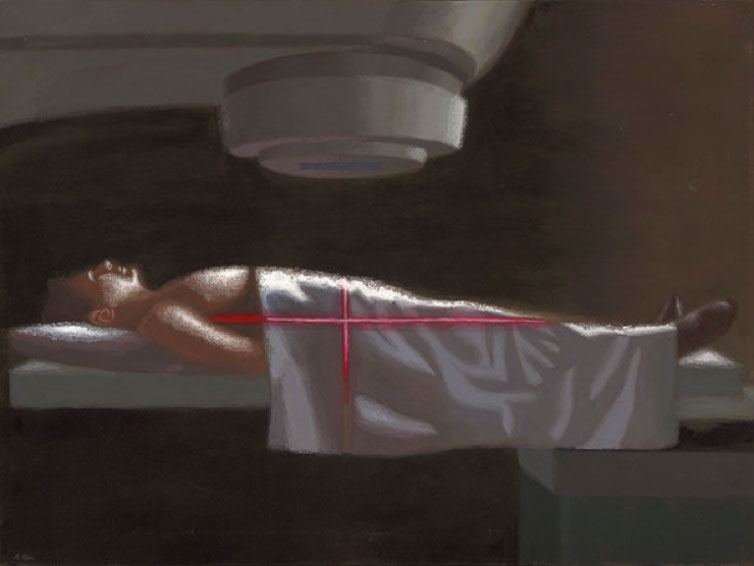Living With Cancer: An Artist’s View
By Susan Gubar NEW YORK TIMES Blog Feb 6, 2014
Susan Gubar writes about life with ovarian cancer.
“Radiation,” 1989. Collection of the Art Gallery of Nova Scotia. Credit Courtesy of the Robert Pope Foundation
Living With Cancer: An Artist’s View
Every time I sign a consent form, I wonder how informed I really am. Do physicians — can physicians— convey the consequences of their treatments to cancer patients? Or is this where artists step in?
A few years before the Canadian painter Robert Pope died in 1992, he dealt with an aggressive form of Hodgkin’s disease by undergoing a succession of standard treatments and by creating evocative canvases about the fraught experiences of cancer patients. Social realism meets surrealism in large paintings that portray the loneliness of sick men and women within the sterility of contemporary hospitals. Pope’s works —reproduced in the book “Illness & Healing” — ask us to think about blood sacrifice: about patients as well as caretakers reenacting archaic, fearful rituals in technologically advanced settings.
Take, for example, his painting “Radiation,” in which a man lies alone on a narrow plank beneath a huge machine directing rays at his abdomen. The artist explains that “the red lasers which are used for positioning suggest a Christian cross, the table the man lies on is like an altar, he is covered with a white shroud, the machine hovers above him like an idol or faceless god that must be propitiated with bodily sacrifices.” Holding still in a black void, the marked man is caught in the beamed cross-hairs. He has to expose himself to a dreaded otherness that he cannot possibly understand and that all others flee. Will its invisible powers heal or harm him?
“The Hug,” 1990. Collection of W.K. Kellogg Health Sciences LibraryCredit Courtesy of the Robert Pope Foundation
In another painting, “Chemotherapy,” a turbaned woman lying on her side pulls up a sheet to cover herself. Beneath her, in the foreground, a disproportionately large syringe of Adriamycin looms. The chemical is red, like life-giving blood and the Red Cross, but also like an alarming stop sign or the inferno of its “red devil” nickname. The knot on her turban parallels the knot of her clenched knuckles, all imbued with the purple pigment called “caput mortuum” (which looks like dried blood and means “dead head”). Does the patient shrink from a drug that will debilitate her or accept its curative capacities?
Such ambiguous images address the isolation of treatment. In paintings that include other figures, the perspective generally remains that of the patient in the hospital bed — again prone, but sometimes without a head. For we view the scene from the patient’s perspective, as if we were he. From his vantage, white-coated physicians tower over him, as do most visitors.
In a self-portrait with Robert Pope’s doctor, the physical intimacy of the standing physician with the seated patient is meant to convey the relationship between “priest and layperson.” Next to a bedside picture of Jesus in another work, Mr. Pope draws a tray of syringes to suggest that “faith in science has replaced faith in religion.”
Even when the artist’s figures are upright and vertical and entwined, they are riven on the stake. In the six-foot high “Hug,” the clasping patient and caregiver are divided — here by the IV rod that sunders the couple “like a dagger,” in the artist’s words. Although the man and woman encircle each other in their embrace, they are cleaved by the cross of the IV pole, holding high its bag of solutions. The intravenous tubes undulating around the pole form the spiral figure of infinity, although in some drafts the tubes look serpentine. Will the loving couple be destroyed by venomous toxins or sustained in the continuum of life and death? In the cancer dance, patient and caregiver remain indistinguishable since both are entangled in the paraphernalia of treatment.
Though we accept ambiguity in art, it is harder to accept in science, harder still in medicine. Robert Pope’s work reminds us that often patients and caregivers cannot fathom what we sign up for. Even when physicians try to communicate the consequences of their prescriptions, patients need to make a leap of faith.
Mr. Pope’s paintings make me wonder: Is cancer treatment a form of religion, a means of transformation that involves its own rituals, trials, high priests, sacraments, vestments and bodily signs for people in need of a miracle and convinced that we have to be stripped of everything before we can be reborn?
In “Stations of the Heart,” a memoir about his son’s death from metastatic melanoma, the theologian Richard Lischer writes, “The religion of cancer treatment holds out the carrot of survival. It confuses the prolongation of life with salvation.”
Do chemotherapy and radiation endanger more precious forms of redemption: the wholeness of the human spirit, connectedness, and compassion?
Susan Gubar is a distinguished emerita professor of English at Indiana University and the author of “Memoir of a Debulked Woman,” which explores her experience with ovarian cancer.

